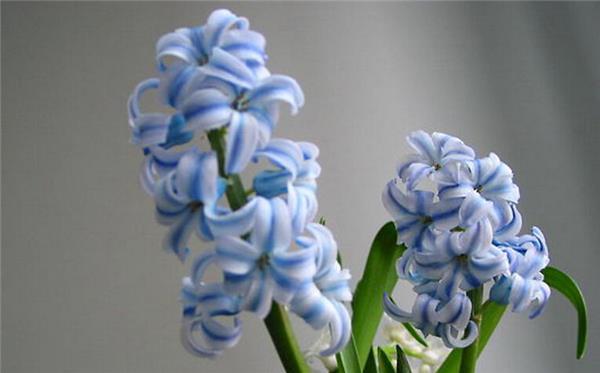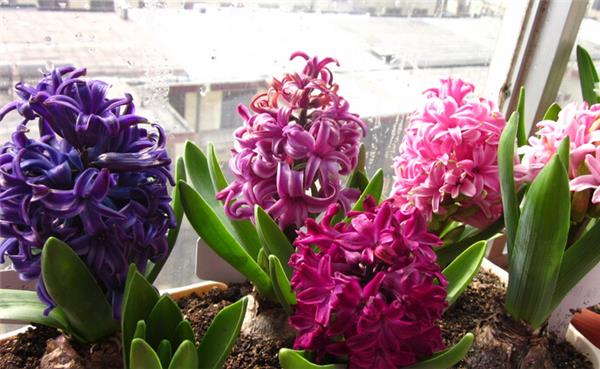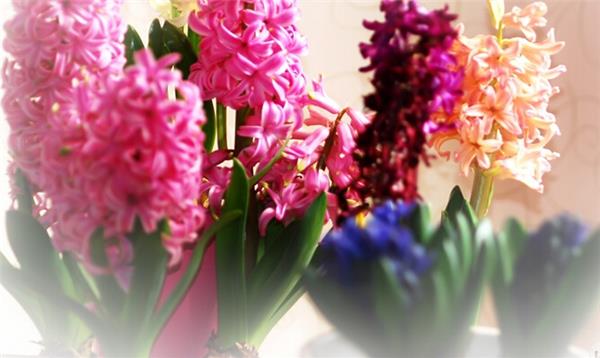What do different colors of hyacinths mean?
Hyacinth is native to the eastern Mediterranean coast and likes cool, moist and sunny environments. Hyacinth blossoms very beautiful, giving people a strong sense of vitality, loved by many people. It also has a lot of fancy mood, different colors of hyacinth flowers have different meanings. What does hyacinth stand for? What is the different meaning of hyacinth in different colors? The editor has sorted out the relevant knowledge and content for everyone here, indicating that while raising their favorite hyacinth flowers, they should master more relevant knowledge of hyacinth flowers.

What does hyacinth stand for?
The flower words and symbols of hyacinth represent meaning: as long as you light the fire of life, you can enjoy a rich life together.
The fancy language of the red hyacinth is-- touching love
Blue hyacinth is the ancestor of all hyacinths, so its fancy language is-life.
Hyacinth: victory, competition, joy, love, happiness, affection, admiration, stubbornness, life
Purple hyacinth: sad, jealous, melancholy love (get my love, you will be happy)
White hyacinth: tranquil, quiet love (love that dare not show)
Red hyacinth: the love that moves me (your love fills my heart)
Blue hyacinth: perseverance, chastity, as happy as to see you.

Yellow hyacinth: happy, happy, very happy with you
Fan Fengxinzi: admiration and romance
There is another beautiful legend about hyacinth:
Legend has it that Heisinthers, a handsome young man, is good friends with Apollo, the god of the sun, and Jeffries, the god of the west wind, likes Heicinthers very much and is often jealous of it, but Heisinthers always likes Apollo and often plays with him. One day, when they were happily throwing discus on the prairie, they happened to be found by Jeffries, who was hiding in the bushes. He felt very uncomfortable and wanted to play a trick on them.
When Apollo threw the discus at Heisinthers, the jealous god of the west wind secretly blew the heavy discus on his forehead, bleeding like columns for a moment, and the handsome boy died. While Apollo was alarmed, he picked up his dead friend with heartache. "Oh!" Alas! with a sigh, I saw blood gushing from Hershinthers' wound, falling to the ground and flowing into the grass.

Soon after, there was a string of purple flowers in the grass. Apollo apologized by taking the name of the beautiful boy as the flower name, which we literally translated as hyacinth. The purple hyacinth has since been regarded as the spokesman of "jealousy". The Greek word Ai is synonymous with Aei (meaning "forever"), so hyacinth also symbolizes "everlasting remembrance". No wonder Europeans and Americans often carve hyacinth patterns on the tombstones of their relatives to show "everlasting remembrance".
Europeans have a special affection for hyacinth. Venus, the goddess of beauty and love, likes to collect the dew attached to the hyacinth petals to make the skin more beautiful and smooth. In Britain, blue hyacinth has always been an indispensable symbol of bride bouquet or decorated flowers in weddings, hoping to bring happiness.
The general method of potted hyacinth culture is to plant bulbs in a nutrition bowl in September, keep them in the sun, move them into a greenhouse in November, and blossom during the Spring Festival the following year. The following details explain the knowledge requirements of hyacinth flower culture.

Culture method of hyacinth
❉-1, seed bulb selection: as the nutrients needed for hyacinth flowering are mainly supplied by the nutrients stored in the bulbs and leaves, as long as the epidermis is not damaged, the fleshy scales are not too wrinkled, and the bulbs are hard, heavy and full, can they produce rich and beautiful flowers.
❉-- 2. Soil requirements: hyacinth cultivation requires fertile soil and high organic matter content. It is best to use sandy soil with good drainage. Before planting, the soil should be humidified and dried for a day before planting. It is required that topdressing is often applied during the growth period, and the soil should be loosened in time after emergence. You can choose to apply topdressing once in winter, before flowering in spring and again after blooming.
❉-- 3, light: hyacinth culture, to maintain sufficient sunlight in order to ensure normal growth. If the light is too weak, it will lead to hyacinth plant thin, bud small, flowers early Xie, leaves yellow and so on, then the incandescent lamp can be used to fill the light at about 1 meter; but too strong light will also cause leaves and petals to burn or shorten the florescence. Bulbs should not be exposed to direct sunlight before sprouting.
❉-4, temperature and humidity regulation: too high temperature will lead to abnormal growth of hyacinth, blind flower rate is too high, preferably less than 15 ℃, can be increased by spraying, ground watering, and can also be ventilated to reduce humidity; while too low temperature, flower buds will suffer frost damage, hyacinth in the growth process, the bulb at 2 to 6 ℃ low temperature root growth is the best. Soil moisture should be kept between 60-70%, too high, root respiration is inhibited and perishable, too low, the aboveground part wilts, or even dies.

❉-5, water hyacinth: the water surface should have 1-2 cm of space from the bulb, do not immerse the bulb in water, but put the bulb on the bottle surface. After the root is rooted, the water level can be lowered to the water surface that can just be touched by the root, so that the root can fully absorb oxygen and promote the growth of the root. After the root is developed, the container can be covered with black cloth to make the ball heel develop further.
At the same time, to keep the water quality in the bottle clean, change the water once a week, such as adding a nutrient solution, depending on the turbid degree of the water, and put it in the shade when the bulb bud grows to 5 meters. Wait for the root system to fully grow and move to the warm southward windowsill with sufficient scattered light, and often add water to soak the bulb.

The above is the explanation of the words about hyacinth summarized by the editor and how to raise hyacinth, hoping to help people who like hyacinth better understand and protect hyacinth.
If the light is too weak, it will lead to hyacinth plant thin, bud small, flowers early Xie, leaves yellow and so on, then the incandescent lamp can be used to fill the light at about 1 meter; but too strong light will also cause leaves and petals to burn or shorten the florescence. Bulbs should not be exposed to direct sunlight before sprouting.
❉-4, temperature and humidity regulation: too high temperature will lead to abnormal growth of hyacinth, blind flower rate is too high, preferably less than 15 ℃, can be increased by spraying, ground watering, and can also be ventilated to reduce humidity; while too low temperature, flower buds will suffer frost damage, hyacinth in the growth process, the bulb at 2 to 6 ℃ low temperature root growth is the best. Soil moisture should be kept between 60-70%, too high, root respiration is inhibited and perishable, too low, the aboveground part wilts, or even dies.

❉-5, water hyacinth: the water surface should have 1-2 cm of space from the bulb, do not immerse the bulb in water, but put the bulb on the bottle surface. After the root is rooted, the water level can be lowered to the water surface that can just be touched by the root, so that the root can fully absorb oxygen and promote the growth of the root. After the root is developed, the container can be covered with black cloth to make the ball heel develop further.
At the same time, to keep the water quality in the bottle clean, change the water once a week, such as adding a nutrient solution, depending on the turbid degree of the water, and put it in the shade when the bulb bud grows to 5 meters. Wait for the root system to fully grow and move to the warm southward windowsill with sufficient scattered light, and often add water to soak the bulb.

The above is the explanation of the words about hyacinth summarized by the editor and how to raise hyacinth, hoping to help people who like hyacinth better understand and protect hyacinth.
Related
- Wuhan Hospital Iron Tree Blooming Result Was Instantly Frightened by the Gardener Master
- Which variety of camellia is the most fragrant and best? Which one do you like best?
- What is the small blue coat, the breeding methods and matters needing attention of the succulent plant
- Dormancy time and maintenance management of succulent plants during dormancy
- Minas succulent how to raise, Minas succulent plant pictures
- What are the varieties of winter succulent plants
- How to raise succulent plants in twelve rolls? let's take a look at some experience of breeding twelve rolls.
- Attention should be paid to water control for succulent plants during dormant period (winter and summer)
- Watering experience of twelve rolls of succulent plants
- Techniques for fertilizing succulent plants. An article will let you know how to fertilize succulent plants.



